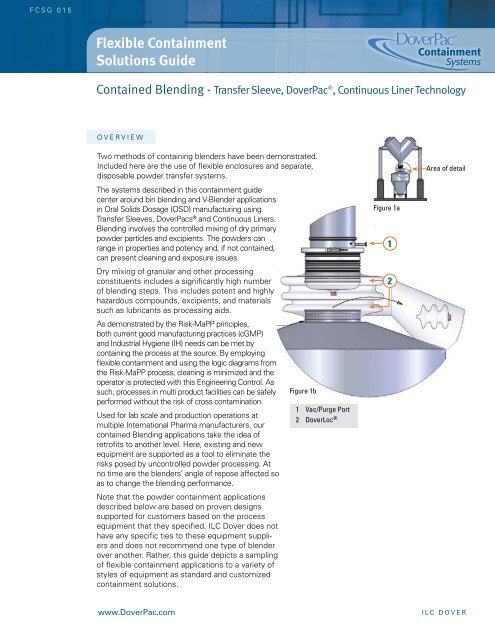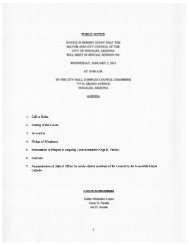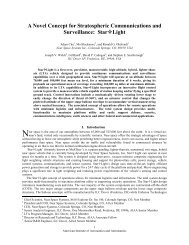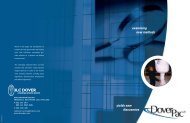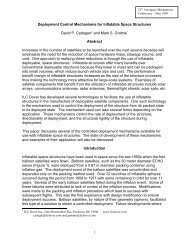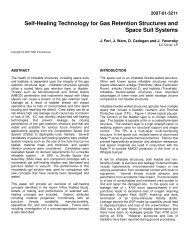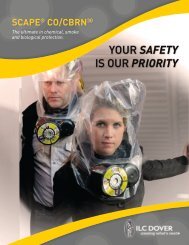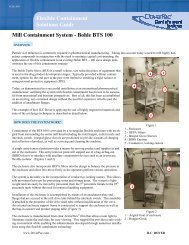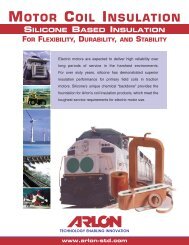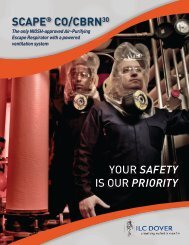Flexible Containment Solutions Guide - Team-Logic
Flexible Containment Solutions Guide - Team-Logic
Flexible Containment Solutions Guide - Team-Logic
You also want an ePaper? Increase the reach of your titles
YUMPU automatically turns print PDFs into web optimized ePapers that Google loves.
FCSG 015<br />
<strong>Flexible</strong> <strong>Containment</strong><br />
<strong>Solutions</strong> <strong>Guide</strong><br />
<strong>Flexible</strong> <strong>Containment</strong> <strong>Solutions</strong> <strong>Guide</strong><br />
<strong>Containment</strong><br />
Systems<br />
Contained Blending - Transfer Sleeve, DoverPac ® , Continuous Liner Technology<br />
Overview<br />
Two methods of containing blenders have been demonstrated.<br />
Included here are the use of flexible enclosures and separate,<br />
disposable powder transfer systems.<br />
The systems described in this containment guide<br />
center around bin blending and V-Blender applications<br />
in Oral Solids Dosage (OSD) manufacturing using<br />
Transfer Sleeves, DoverPacs ® and Continuous Liners.<br />
Blending involves the controlled mixing of dry primary<br />
powder particles and excipients. The powders can<br />
range in properties and potency and, if not contained,<br />
can present cleaning and exposure issues.<br />
Dry mixing of granular and other processing<br />
constituents includes a significantly high number<br />
of blending steps. This includes potent and highly<br />
hazardous compounds, excipients, and materials<br />
such as lubricants as processing aids.<br />
As demonstrated by the Risk-MaPP principles,<br />
both current good manufacturing practices (cGMP)<br />
and Industrial Hygiene (IH) needs can be met by<br />
containing the process at the source. By employing<br />
flexible containment and using the logic diagrams from<br />
the Risk-MaPP process, cleaning is minimized and the<br />
operator is protected with this Engineering Control. As<br />
such, processes in multi product facilities can be safely<br />
performed without the risk of cross contamination.<br />
Used for lab scale and production operations at<br />
multiple International Pharma manufacturers, our<br />
contained Blending applications take the idea of<br />
retrofits to another level. Here, existing and new<br />
equipment are supported as a tool to eliminate the<br />
risks posed by uncontrolled powder processing. At<br />
no time are the blenders’ angle of repose affected so<br />
as to change the blending performance.<br />
Note that the powder containment applications<br />
described below are based on proven designs<br />
supported for customers based on the process<br />
equipment that they specified. ILC Dover does not<br />
have any specific ties to these equipment suppliers<br />
and does not recommend one type of blender<br />
over another. Rather, this guide depicts a sampling<br />
of flexible containment applications to a variety of<br />
styles of equipment as standard and customized<br />
containment solutions.<br />
Area of detail<br />
Figure 1a<br />
1<br />
2<br />
Figure 1b<br />
1 Vac/Purge Port<br />
2 DoverLoc ®<br />
www.DoverPac.com<br />
ILC DOVER
FLEXIBLE <strong>Containment</strong> <strong>Solutions</strong> <strong>Guide</strong><br />
How does it work and what are the applications<br />
Three methods of flexible containment using powder transfer systems have been applied to blenders.<br />
These include charging and offloading with transfer sleeves, charging and offloading with Dover-<br />
Pacs ® and offloading with a continuous liner system.<br />
This rugged film provides a safe working environment while enabling the enhancements developed<br />
through numerous installations using this flexible containment technology.<br />
The Transfer Sleeves, Continuous Liners and DoverPacs ® are made from ArmorFlex ® film. This rugged<br />
monolayer film brings regulatory pedigree for materials of contact as well as proven use from<br />
multiple process applications.<br />
The use of flexible containment allows the end user to process contained when needed or follow existing,<br />
open processing procedures when containment is not required. In both cases, cost savings are<br />
realized by modifying an existing design or using an existing piece of equipment with no modifications.<br />
Charging and offloading with transfer sleeves<br />
A transfer sleeve is essentially a flexible chute that attaches to the blender and the piece of process<br />
equipment being used to fill or offload the blender. Contained attachment is achieved through the<br />
use of a multiple groove canister on the blender and on the IBC, for example. The sleeve is then<br />
clamped onto the blender and IBC to support powder flow.<br />
In the case of a bin blender, the bin can be attached to the tablet press or to an interface in the floor<br />
of the suite where powder transfer to a piece of equipment on a lower floor is part of the process.<br />
Gemco V-Blender to IBC<br />
In the example shown in figures 1a and 1b, a 30 cubic foot Gemco blender is being emptied to a<br />
rigid IBC. The application posed a challenge in lining up for docking with the IBC and in clearances<br />
while the blender rotates.<br />
The system includes a 5 groove multiple o-ring canister attached to the V-Blender, a 2 groove canister<br />
clamped to the IBC, the Transfer sleeve, the DoverLoc ® , and the crimp components. The transfer sleeve<br />
is also made with an ArmorFlex ® film.<br />
Charging and offloading with DoverPacs ®<br />
DoverPacs ® are a proven method for contained transfer from vessel to vessel. This system consists<br />
of a liner that is attached to a multiple o-ring groove canister. By incorporating a fill and discharge<br />
neck the same liner can be filled at one process point and discharged into another.<br />
DoverPacs ® utilize the crimping system and ArmorFlex ® family of films developed by ILC. Various<br />
standard and custom designs are available to fit any process need from lab scale to full production.<br />
Conta Bin Blender Charging and Discharging<br />
While DoverPacs ® can be used for charging and discharging any type of blender, the wall mounted<br />
Bin blender shown is an example of an application with this flexible containment technology. In this<br />
design, the process is supported by the installation of a single, 8”(200 mm) multiple o-ring groove<br />
canister on the bin which allows for contained powder transfer through one port for charging, figure<br />
2a, and offloading, figure 2b, the bin. This minimizes the capital expense versus a rigid isolator even<br />
further and allows for existing bins to be used without modification.<br />
Following this step the filled 20L DoverPac ® is used to charge a capsule filler.<br />
2
FLEXIBLE <strong>Containment</strong> <strong>Solutions</strong> <strong>Guide</strong><br />
Offloading with a continuous liner system<br />
Utilizing a similar multiple o-ring groove canister,<br />
ArmorFlex ® film, and crimping technique<br />
as above, this system allows contained offloading<br />
into drums. Liners are factory packed<br />
with standard bundles of 150’ (45 m), 100’ (30<br />
m), and 50’ (15 m). Custom lengths are also<br />
provided.<br />
Gemco V-Blender to Continuous Liners<br />
Figure 3 is an example of offloading a 30 cubic<br />
foot V-blender with a Continuous Liner system<br />
to drums. In this case the rotational clearance<br />
did not allow the Continuous Liner canister to<br />
be installed directly on the blender as in other<br />
applications.<br />
To account for the clearance, a three groove<br />
canister was mounted on the blender and the<br />
standard canister was mounted on the Transfer<br />
Stand shown. In addition, the stand allows the<br />
Operator to reach the valve on the outlet of<br />
the blender and the transfer sleeve since this<br />
interface is 92” (2337 mm) above the floor in<br />
this installation.<br />
A transfer sleeve is then used as the contained<br />
chute to direct the powder from the blender<br />
to the Continuous Liner. The Continuous Liner<br />
is pulled into a drum that sits on the existing<br />
scale in the floor between the blender supports.<br />
This allows for the drum to be weighed<br />
as part of the process.<br />
Input from the operation of this system included<br />
“this saved us significant cleaning time<br />
as we no longer need to hose down the entire<br />
suite”. This is a key in the Risk-MaPP logic for<br />
supporting operations in a multi process facility<br />
by eliminating cross contamination concerns.<br />
Figure 2a<br />
Figure 3<br />
1 Blender Mounted<br />
Canister<br />
2 Transfer Sleeve<br />
1<br />
2<br />
Figure 2b<br />
1 Bin<br />
2 DoverPac ®<br />
1<br />
2<br />
3<br />
4<br />
3 Transfer Stand<br />
4 Continuous Liner<br />
System<br />
3
FLEXIBLE <strong>Containment</strong> <strong>Solutions</strong> <strong>Guide</strong><br />
What are the Features and Benefits of this Technology<br />
Features<br />
• Retrofit to existing equipment design<br />
• Process and Technical areas separated<br />
• Validated containment technology<br />
• Passive system<br />
• <strong>Flexible</strong> materials<br />
• Disposable components<br />
• Adaptable to other process equipment<br />
• No blender shape modifications<br />
Benefits<br />
• Complies with the Risk-MaPP initiative<br />
• Provides the lowest overall cost of process<br />
ownership through low capital and operating<br />
cost including reduced cleaning and cleaning<br />
validation<br />
• Fastest turnaround of a processing suite for<br />
subsequent manufacturing campaigns<br />
• Process is contained without contamination of<br />
motor, drive shaft, and controls<br />
• Nanogram containment levels achieved<br />
• Does not affect ATEX and Ex ratings<br />
• Ergonomics maximized<br />
• Speed of implementation<br />
• No affect on blend uniformity<br />
What containment level provided<br />
OEB 5 with results in the nanogram range. This is based on customer test data, other proven applications,<br />
third party testing to the “SMEPAC” protocols on similar designs, and the 100% inflation tests<br />
performed on the deliverable systems.<br />
OEB 1 OEB 2 OEB 3 OEB 4 OEB 5<br />
10,000 to 1000 1,000 to 100 100 to 50 50 to 10 10 to 1 1 to 0.1 0.1 to 0.01<br />
Occupational Exposure Levels above are in μg/m3.<br />
Why use this over other technologies<br />
One of the driving forces of this technology is that it reduces the risk of cross contamination in multi<br />
process facilities and it provides safety to the operators in both multi process and dedicated facilities.<br />
By using this disposable Engineered Control, highly hazardous powders are contained at the source<br />
which significantly reduces cross contamination risks and cleaning of process suites and rigid containment<br />
devices.<br />
The cost of ownership, ergonomic advantages, and speed of delivery benefits of this flexible solution<br />
also far outweigh those of rigid isolation systems.<br />
Tools such as Lean Manufacturing come into play more and more. For example, the time to clean and<br />
validate the cleaning are major bottlenecks for processing efficiencies in the plant. Being able to minimize<br />
this part of the process results in getting products to market faster and at an overall reduction<br />
in operating costs when considering labor, utilities, and waste disposal costs. It also supports getting<br />
multiple products to market faster within an existing facility without risking product safety.<br />
MKT-0070 Rev A<br />
4<br />
www.DoverPac.com | customer_service@ilcdover.com | PH 302.335.3911 | 800.631.9567<br />
ONE MOONWALKER RD., FREDERICA, DELAWARE USA 19946-2080


